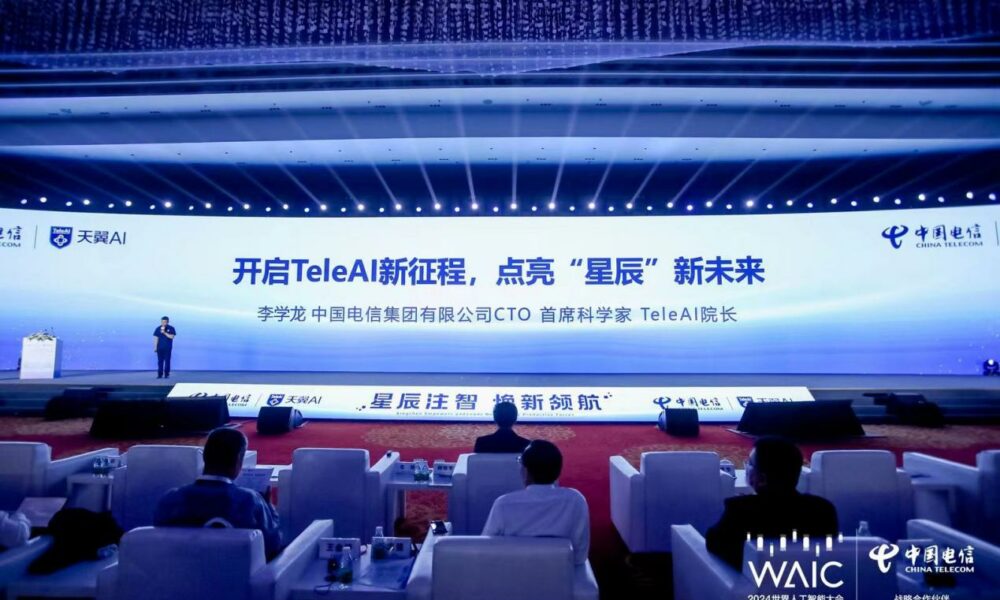China Telecom Launches A Documentation-oriented LLM-driven Application, New Paradigm of Software Development

China Telecom AI Technology Co., Ltd. and the Institute of Artificial Intelligence (TeleAI) recently released XINGCHEN Large Model – Software Factory, an LLM-driven software development platform. It initiates a new documentation-oriented paradigm in software development, reshaping the current software development workflow by utilizing a self-developed multimodal large model.
It’s widely accepted that the two core procedures of the modern software development workflow are requirement analysis and functionality implementation. Requirement analysis takes the form of product documentation written in everyday natural language that is not immediately applicable to software development. Functionality implementation, on the other hand, is all about writing codes that are abstract directives only understood by machines and well-trained professionals. It is suitable for feature implementations instead of project requirements descriptions. Codes are efficient for implementing requirements, but serve no good for depicting them.
Documentation-oriented development means composing clear and easy-to-understand product documentation and leaving all coding stuff to large models. With extra support of automated testing and deployment, efficient developments and launches are no longer castles in the air.
From now on, developers no longer need to sweat over the cycle of requirement understanding, coding and debugging. They just need to focus on software requirement analysis and maintenance of the product documentation and Xingchen Software Factory will do the rest.
Researchers from TeleAI proposed this automated software development framework powered by large multimodal models. Requirements regarding different sections of software development – frontend, backend, UI and more – can be aggregated into one single requirement documentation that is then parsed into step-by-step prompts to invoke code generation. This framework also provides features like automatic debugging and testing, paving all the way to one-click deployment and launch of projects.
They have built the software factory with three core capabilities: process innovation, controlled code generation, and upgraded interaction modes.
Complexity Made Easy: A New Document-Driven Development Collaborative Workflow for Software Development
Software development involves personnel from various roles. Seamless transmission of product development requirements and team-level consensus of such requirements are vital to successful application development.
The Xingchen Software Factory introduces the idea of documentation-oriented projects to make your team synchronized. Xingchen uses natural-language-styled documentation as the sole demonstration of projects, enabling the involvement of collaborators with modest programming skills. The codeless nature of this platform makes requirement propagation more efficient and software development more collaborative.
The document-centered development paradigm frees users from tedious coding and debugging, allowing more concentration on the implementation of core functionalities.
From Documentation to Code: Large Multimodal Models for Code Generation
The foundation models employed in Xingchen, like most of their LMM counterparts, are stochastic in nature. Codes generated by such models risk the disadvantage of weak robustness, controllability, and maintainability.
In response to such concerns, the Xingchen Software Factory introduces the concept of code primitives. Code primitives are minimal functional snippets extracted from massive projects. Breaking project repositories down into code primitives helps decoupling primitives from contexts within which business-specific logics might be entangled, and large models finetuned with code primitives are prone to generating better maintainable codes. On top of this, principles about function calling are extracted from standard libraries to form an auxiliary corpus for model finetuning, which boosts code controllability and development efficiency.
The introduction of code primitives establishes paradigms for large models to generate well-organized codes, enabling fast and stable documentation-to-project generation.
Seamless Interaction: A New Programming Interaction Mode with LLM
Most current code generation products are only capable of generating code snippets in multi-round conversations with users. Such configurations deem large models as consultants that give coding suggestions along with trivial template coding, most of which are far from readily usable, and the system throughput is also limited by the length of context windows. These products are unable to support project-level code generation, deployment, maintenance and upgrading.
The Xingchen Software Factory starts a brand-new interaction schema with LLMs that resembles the canonical in-person software development workflow. Users are no longer involved in conversations with LLMs, instead they just need to focus on writing product requirements and documentations. Xingchen provides step-by-step instructions that guides users through the whole development, test and deployment procedures. In Xingchen, what you write is what you get.
In summary, the Xingchen Software Factory provides an end-to-end service that enables efficient and project-level software development, upgrading and management.
China Telecom is rapidly promoting the application of LLMs in the software development area
China Telecom has long been preparing itself, both technically and strategically, for the era of large models. The group now possesses an R&D team of approximately 800 members led by Professor Xuelong Li, CTO of China Telecom and President of Institute of Artificial Intelligence (TeleAI), China Telecom, P. R. China to conduct persistent foundational and advanced research.
A solid matrix of foundation models and business models, both developed by self or in cooperation with leading companies, has been established, covering over 500 scenarios in more than 20 industries, such as education, politics, and emergency treatment. A data pool with over 500 TB texts, 1.2 billion image-text pairs and PBs of video data has also been established. It is well worth mentioning that the XINGCHEN Large Model – Software Factory is one product among the XINGCHEN family that includes the Xingchen Large Language Model, Xingchen Large Speech Model, and Xingchen Large Vision Model.
The release of XINGCHEN Large Model – Software Factory propels the employment of large multimodal models in software engineering and highlights the debut of TeleAI on the forum. TeleAI, as the major force among state-owned AI research institutes, will concentrate on advanced AI research and the incorporation of novel techniques with industrial applications.
China Telecom establishes its robust AI ecology upon the soil with solid technological strength and widespread application scope. They are essentially turning next-generation AI into reality and paving the way where AI serves as the new quality productive forces.








